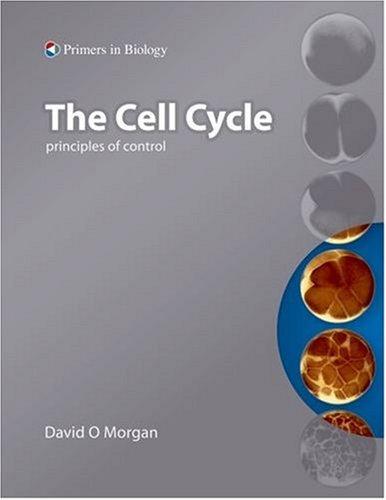

Most ebook files are in PDF format, so you can easily read them using various software such as Foxit Reader or directly on the Google Chrome browser.
Some ebook files are released by publishers in other formats such as .awz, .mobi, .epub, .fb2, etc. You may need to install specific software to read these formats on mobile/PC, such as Calibre.
Please read the tutorial at this link: https://ebookbell.com/faq
We offer FREE conversion to the popular formats you request; however, this may take some time. Therefore, right after payment, please email us, and we will try to provide the service as quickly as possible.
For some exceptional file formats or broken links (if any), please refrain from opening any disputes. Instead, email us first, and we will try to assist within a maximum of 6 hours.
EbookBell Team

0.0
0 reviews
ISBN 10: 0878935088
ISBN 13: 9780878935086
Author: David O Morgan
Introduction: An Overview of the Cell Cycle
1.1 The Central Dogma of Cell Division
1.2 The Major Phases: G1, S, G2, and M
1.3 The Concept of Cell Cycle Control and Checkpoints
1.4 A Note on Model Organisms (Yeast, Frogs, etc.)
Chapter 1: The Core Regulators: Cyclins and Cyclin-Dependent Kinases (CDKs)
2.1 The Discovery of MPF (Maturation Promoting Factor)
2.2 The Families of Cyclins and CDKs in Eukaryotes
2.3 The Mechanism of CDK Activation: Phosphorylation and Dephosphorylation
2.4 Cyclin-CDK Complexes and Their Targets at Different Cell Cycle Phases
2.5 CDK Inhibitors (CKIs) and Their Role in Regulation
Chapter 2: The G1 Phase and Commitment to the Cell Cycle
3.1 The G1 Phase: A Period of Growth and Decision
3.2 The G1/S Transition: The "Point of No Return" (Start in yeast, Restriction Point in mammals)
3.3 The Role of the E2F Transcription Factor and the Rb Protein
3.4 The Role of Cyclin D-CDK4/6 and Cyclin E-CDK2
3.5 Mechanisms of Growth Factor Signaling and Cell Cycle Entry
Chapter 3: The S Phase: DNA Replication
4.1 The Licensing of Origins of Replication (ORC, MCM)
4.2 Firing of Origins and the Role of DDK and CDK
4.3 Preventing Re-replication in a Single Cell Cycle
4.4 The S Phase Checkpoint: Monitoring DNA Integrity
Chapter 4: The G2 Phase and the Mitotic Entry
5.1 The G2 Phase: Preparation for Mitosis
5.2 The Role of Cyclin B-CDK1 (MPF)
5.3 The Wee1 and Cdc25 Regulatory Circuit: The "Yin and Yang" of CDK Activity
5.4 The G2/M Checkpoint: Ensuring DNA Is Fully Replicated and Undamaged
Chapter 5: Mitosis and Cytokinesis
6.1 Prophase and Prometaphase: Chromosome Condensation and Nuclear Envelope Breakdown
6.2 Metaphase: Chromosome Alignment at the Metaphase Plate
6.3 Anaphase: Sister Chromatid Separation
6.3.1 The Anaphase Promoting Complex/Cyclosome (APC/C)
6.3.2 The Role of Securin and Separase
6.4 Telophase and Cytokinesis: Division of the Cell
6.5 The Spindle Assembly Checkpoint (SAC): Ensuring Proper Chromosome Segregation
Chapter 6: Checkpoints: Guardians of the Genome
7.1 The DNA Damage Checkpoint (DDR) Pathway
7.1.1 The Role of ATM and ATR Kinases
7.1.2 The p53 Pathway and its Downstream Targets (e.g., p21)
7.2 The Spindle Assembly Checkpoint (SAC) in Detail
7.3 Checkpoint Activation and Cell Cycle Arrest
Chapter 7: Cell Cycle and Disease
8.1 Cancer: The Cell Cycle Gone Awry
8.1.1 Oncogenes and Tumor Suppressors in Cell Cycle Regulation
8.1.2 Loss of Checkpoint Control and Genomic Instability
8.2 Therapeutics Targeting the Cell Cycle
8.2.1 CDK Inhibitors in Cancer Therapy
8.2.2 Chemotherapy and DNA Damage
8.3 Senescence and Apoptosis in Relation to the Cell Cycle
Conclusion: Future Directions and Unresolved Questions
9.1 The Role of Mechanotransduction in Cell Cycle Control
9.2 The Coordination of Cell Growth and Cell Division
9.3 New Insights from Single-Cell Analysis
david o morgan the cell cycle principles of control
the cell cycle principles of control pdf
the cell cycle principles of control new science press
core control principles of the eukaryotic cell cycle
how is the cell cycle controlled
Tags: David O Morgan, Cell, Cycle